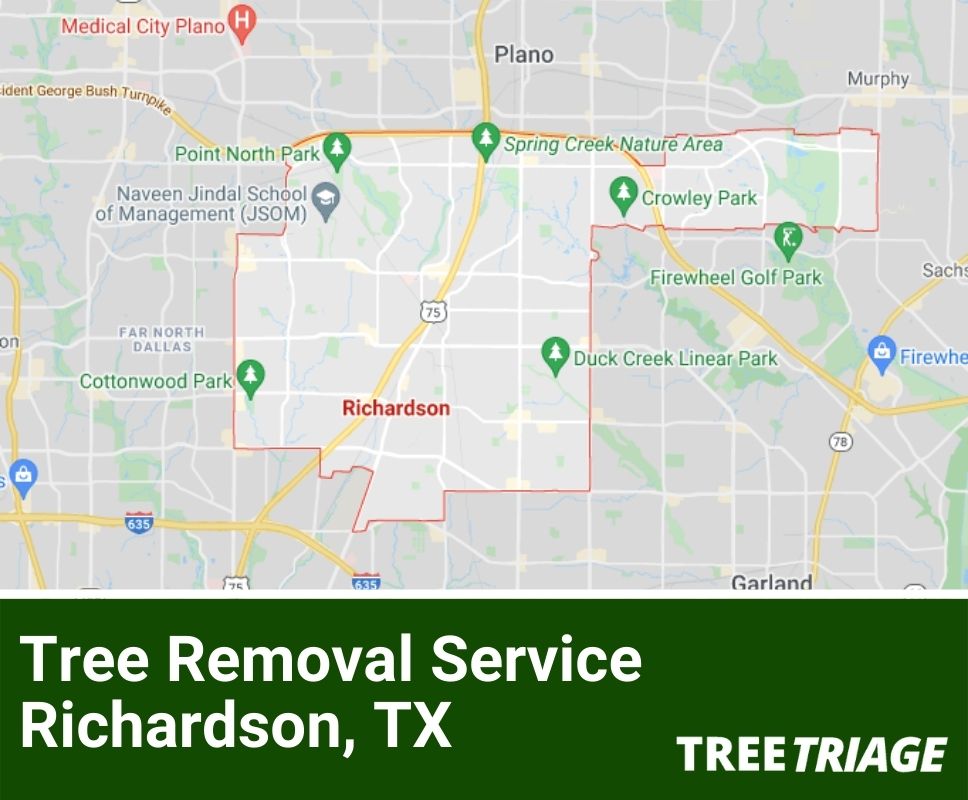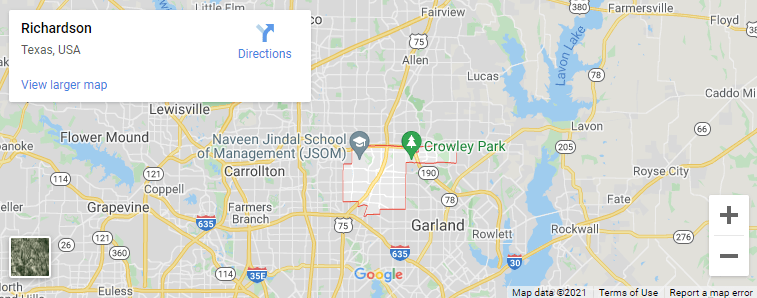Contents (Click To Jump)
- 1 What Are the Most Common Tree Issues in Richardson?
- 2 Does the City of Richardson Provide Any Assistance in Tree Removal Problems?
- 3 Who Is Responsible for Fallen Tree Removal in Richardson?
- 4 How Does the Soil Affect Trees in Richardson?
- 5 Does Weather Affect Tree Health in Richardson?
- 6 What If Dead Trees Are Near Power Lines in Richardson?
- 7 How Much Does Tree Removal Usually Cost in Richardson?
What Are the Most Common Tree Issues in Richardson?
The Dallas area is warm and prone to both drought and flood, all of which can stress trees and cause issues. Because of this, the biggest issue in the area is hypoxylon canker. This primarily affects oaks, but can also affect other hardwood trees. The disease manifests as crusty fungal tissue, generally light to dark reddish-brown to olive-green on part of the tree, which then becomes grey and flakes off to reveal a dark brown material. This eventually becomes large strips on the trunk and major branches.
There is no treatment for hypoxylon canker, and it kills trees within a few years. Trees with the canker should be removed. However, it generally affects only trees already in decline. Properly caring for your trees will help them avoid the disease, which is caused by an opportunistic fungus. Make sure to protect your trees from added stress caused by construction and landscaping, and consider vertical mulching to help support your trees’ roots.
Another common issue is fire blight, which affects apples, pears, and related trees. It’s called so because the leaves and shoots turn black and curl up and look like they have been burned. It can also affect the bark. The treatment for fire blight is to promptly trim the infected branches (if you aren’t sure what to do, call us and we can help you save your tree). If planting these trees, look for cultivars that are known to be more resistant to it. However, avoid the Bradford Pear, which is an invasive plague on the landscape.
Oak wilt has caused significant problems in the Texas Hill Country. A sign is leaves turning brown and then falling; the disease is a fungus that clogs up the vascular systems of red and live oaks. Oak wilt can kill a tree quickly and also infected trees are more vulnerable to hypoxylon canker. Infected trees should be removed quickly, and the root connections between them and healthy trees severed. Fungicide treatment can help slow the progression of the disease but is best used as a preventative. This has to be done by a professional like Tree Triage.
Finally, Texas is one of the few areas where Dutch elm disease has not killed all the elm trees; unfortunately, this means that there is a constant risk of it expanding into the area. The reason Texas has been reasonably protected from this scourge is the predominance of cedar elm, which has some resistance. The disease causes rapid wilting and death of individual leaves and branches and discolored vascular streaking just beneath the bark. Most trees showing signs of Dutch elm disease should be removed, and neighboring trees monitored as it spreads through the roots. Some more resistant elms can be saved if less than 10% of the crown is showing symptoms. Remedial pruning and injections of insecticide can help save a tree. If you want to plant an elm tree, make sure it is cedar elm, not American elm.
Does the City of Richardson Provide Any Assistance in Tree Removal Problems?
While the city does not provide specific assistance cutting down and removing trees, they do offer ‘brush and bulky item collection’, which can be used to remove fallen limbs and other debris. This is most useful for dealing with deadfall after a storm, but for larger trees, you will still need professional tree removal from our arborists.
The city does have initiatives to help homeowners with other tree issues. Two are particularly useful. First of all, they provide a guide to drought-tolerant plants, which includes recommendations for shade and ornamental trees. By planting drought-tolerant trees, you reduce the amount of maintenance you need to do and your risk of having a tree die. The second initiative is Richardson Replants, which has an educational resource to help you replace a damaged or fallen tree.
Who Is Responsible for Fallen Tree Removal in Richardson?
As in most jurisdictions, a tree belongs to the person on whose land the trunk stands. Trees planted in medians and on sidewalks are, thus, the responsibility of the city, and you should make sure to report fallen, damaged, or diseased trees. Trees on your land are your responsibility.
If you’re a homeowner?
Check your insurance; make sure your homeowner’s policy covers tree removal. In most cases, your insurance will cover damage caused by a falling tree, although insurance companies have been known to argue a claim if the tree had a long-standing illness that had not been properly remediated. For this reason, it’s best to call us to have dying trees removed before they fall (and also because many of the tree issues in the area are contagious).
If you’re a renter?
Your landlord is responsible for tree removal if the fallen or potentially falling tree would affect your health and safety, and you have informed them about the issue. Texas law requires that tenants proactively report issues to landlords, rather than obliging landlords to do regular inspections. Also, this can be waived in the lease, making you responsible for all repairs, either at your cost or at your landlord’s. Also, there’s no obligation for your landlord to remove a tree that is not creating a danger.
For the most part, your lease will tell you whether you or your landlord are responsible for tree removal.
If you’re a landlord?
Unless you have got the tenant to agree to a waiver, you are responsible for removing fallen or damaged trees that might present a danger, such as trees that are about to fall into the house.
Otherwise, you can set the lease terms to establish who’s responsible; generally for multi-unit properties tree removal is your responsibility, but you might make it the tenant’s for a single-family home so that they can manage their own landscaping without interference.
If you’re a neighbor?
Your neighbor is responsible if a tree growing on their land falls on your land. In most cases, their homeowners’ insurance will cover the costs. If a tree straddles the property line, it’s wise to proactively talk to your neighbor about who is responsible and how to coordinate maintenance and pruning, and what to do if the tree is diseased.
How Does the Soil Affect Trees in Richardson?
Richardson has less variance in soil type than some places. The entirety of Dallas County is considered to be part of the Blackland Prairie, which has little relief and dark, thick, plastic clay soils. While there’s some variation in underlying geology, you can be fairly sure that your soil is of this or a related type. Soil testing can help you be sure.
Generally, this is good soil and most plants, especially native ones, will manage with no soil treatments other than water. Make sure when selecting trees that you choose ones which like this kind of soil. Trees that are native to areas with sandy soil will not do well in Richardson.
Does Weather Affect Tree Health in Richardson?
The biggest concern for tree health in Richardson is drought. The area has hot summers and cool winters, little snowfall, and uniform rainfall distribution. However, drought and fire danger are common. In fact, there are permanent restrictions on when and how often you can water your yard in Richardson. Generally, you are allowed to run lawn sprinklers twice a week during the summer, on days determined by your address.
This means that we strongly recommend you only plant drought-tolerant trees. Trees weakened by drought are prone to disease, and by planting drought-tolerant trees you help ensure their health and reduce the monetary and time cost of properly maintaining your trees. You should also protect your trees and others by being careful about open flames outdoors. Always obey no burn restrictions and think carefully, even if there isn’t one in place.
Severe storms are not uncommon in the area, and these storms often involve strong winds and hail, which can also damage and even bring down trees. Occasionally, tornadoes are reported in the area that can do significant damage.
What If Dead Trees Are Near Power Lines in Richardson?
Richardson has a number of electricity suppliers. However, Oncor is responsible for dealing with infrastructure, including downed power lines, tree removal, etc., so issues with trees near power lines should be reported to them. You can also call Oncor to arrange for pruning of trees near your power lines. Oncor also provides advice on what trees to grow near power lines so that they don’t grow into the lines and need to be trimmed.
Oncor can help you by making sure that there is no power to lines before a larger scale removal. The goal is always to keep trees away from power lines in the first place.
How Much Does Tree Removal Usually Cost in Richardson?
On average, removing a small tree (less than 30 ft.) costs $125 to $350 for a fallen tree and $353.85 to $483.51 for a standing tree. Larger trees can reach up to about $2,100 in some cases. Spray treatment to protect your trees from disease costs $45 to $90 and trunk injections cost $51.79 to $53.25. These costs are, of course, impacted by a variety of other factors.
Size
Larger trees require more heavy equipment and cost more to remove. There are also often challenges with removing large trees that require great care to be taken. Generally, it costs about $121.25 per hour for time over the standard we expect to remove a small tree.
It will also cost more if you want stump removal, which we strongly recommend for trees that have died as a result of disease so as to reduce the risk of root graft contagion to neighboring trees.
Location
If we have to remove a tree carefully because it is about to fall onto a structure, that will cost you more. Sometimes we may need to bring in special gear or extra people, which will increase the cost. However, if the tree is easy to access and the trunk and branches can be removed easily, we may be able to charge less.
Disease Control
Some of the biggest tree problems in Richardson are caused by contagious diseases. When we remove a sick tree we may recommend extra steps to protect your other trees from catching the illness. This generally means root separation, which is done using trenching tools or other special equipment and ensures that diseased root tissue is not grafted onto the next tree over. This is how fungal infections spread from tree to tree. Obviously, this increases the time and gear we use and comes with a higher price.






